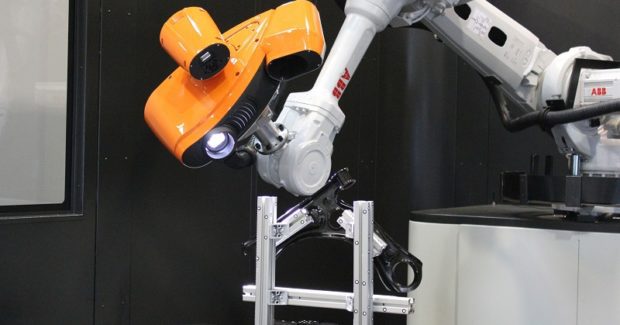Robot Inspection: The Future of Flexible Manufacturing
For automated inspection of manufactured parts in shorter cycle times, the Robot Inspection System from ABB / NUB3D raises quality and reduces the risk of errors by rapidly recording and comparing highly detailed geometric and surface data with digital CAD models.
Posted: January 30, 2019
Developed through a collaboration between ABB Robotics Inc. (Auburn Hills, MI) and NUB3D, S.L. (Barcelona, Spain), the Robotic Inspection System consists of a 3D white-light scanning sensor mounted to the arm of an ABB robot, relying on the agility of the robot to provide the precise movements necessary for the sensors to access most areas of both simple and complex parts from the optimum angle. The sensor technology rapidly records and compares highly detailed geometric and surface data with digital CAD models, enabling the automated inspection of manufactured parts and pieces, helping factories to reduce cycle times while raising quality and reducing the risk of quality control errors. This turnkey inspection and quality control system is ideal for automotive OEMs, aerospace manufacturers and shops competing in other metals sectors.
This innovative system represents the future of flexible manufacturing, enabling a high level of automation with advanced data analysis that can be used to optimize production processes and help manufacturers improve quality and productivity, while accommodating greater product variation and customization in smaller lots. The end objective of both systems is the same: scan the part, compare it to a perfect CAD model and assess the quality of the part based on the data provided. This system is different than others because it uses a 3D optical scanner with structured white-light technology to compute a point cloud that is then compared to the CAD model. A Sidio Lite or Sidio Airus laser scanner is integrated into the system to do the measurement. Every shot taken provides 1.5 million and 5 million points for each model, respectively, of the ABB/ NUB3D scanner. The extremely good speed, accuracy and repeatability of the system is high and is independent of the robot’s accuracy and repeatability. Being a matter of microns, Robotic Inspection System accuracy is able to find defects that other systems cannot detect.
The benefit of this increased accuracy is earlier detection of component degradation. When components start to dimensionally degrade over time or small imperfections begin to appear, they will be detected earlier with this system, whereas other inspection systems would allow the degraded part to pass through. Early detection mean rectification can be implemented earlier, preventing defective components from reaching the public domain before becoming potentially catastrophic. While more accurate, the Robotic Inspection System is also suited to handle the more mundane inspection tasks, like making sure parts are functionally fit and that various components will all actually fit together, etc.
For arc welding and machine tending applications, the compact IRB 1660ID robot from ABB Robotics is the most versatile robot in the mid-size class. Its Integrated DressPack design is easier to program and simulate predictable cable movements than standard robots with externally-routed cables, decreasing cable wear and damage and reducing maintenance costs by 50 percent. Its compact footprint allows for more efficient robot cell layouts, saving valuable space on the factory floor. To meet the growing demand for superior and even quality in arc welding applications, the IRB 1660ID features a stronger, more rigid upper arm, with a reach of 1.55 m and a payload of 6 kg. It can accommodate heavier weld torches and provides improved wire feeding control near the arc to guarantee high volume production. Combined with TrueMove™ technology and the “Accuracy mode” motion process, this provides 0.05 mm path repeatability for excellent welding results.
The Integrated DressPack allows this robot to move at maximum acceleration and speed, enabling fast and reliable movements ideal for machine tending applications. The risk of collision in confined spaces is eliminated and its combined 1,390 deg working range of axes 4, 5 and 6 provides outstanding agility inside CNC machine tools. Along with a new generation of accurate, efficient and reliable motors, the IRB 1660ID robot is as rigid as possible to better protect it and equip it for operating in confined spaces. For machine tending vertical lathes, horizontal and vertical machining centers, 5-axis machines and grinders in both low and high volume production, standardized FlexLoader™ compact machine tool tending cells from ABB use a 6-axis robot matched to the reach and payload requirements of the specific application. User-friendly vision guidance provides the flexibility to automate the machine tending of parts that range from small to very large, increasing machine tool utilization by as much as 60 percent while reducing operating costs.
ABB Robotics Inc., 1250 Brown Road, Auburn Hills, MI 48326, 248-391-9000, www.abb.com/robotics.






















